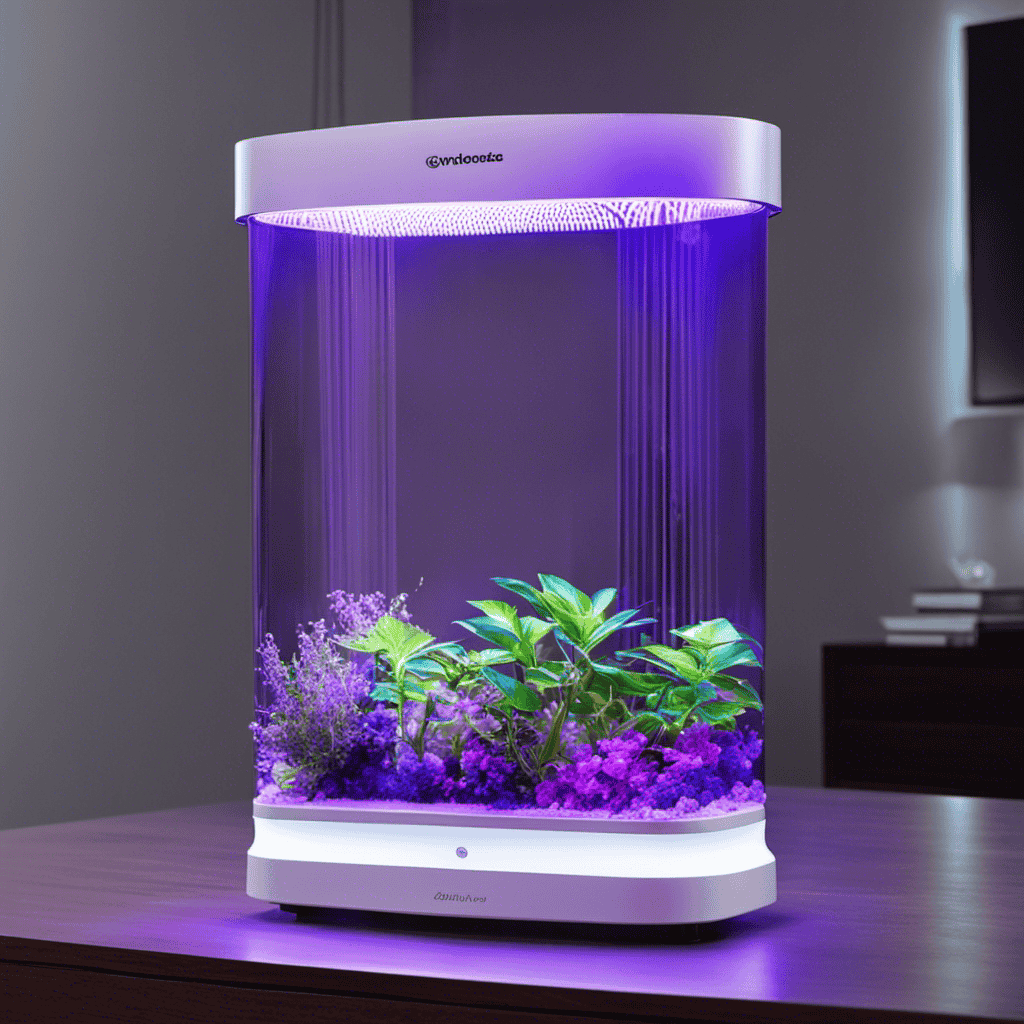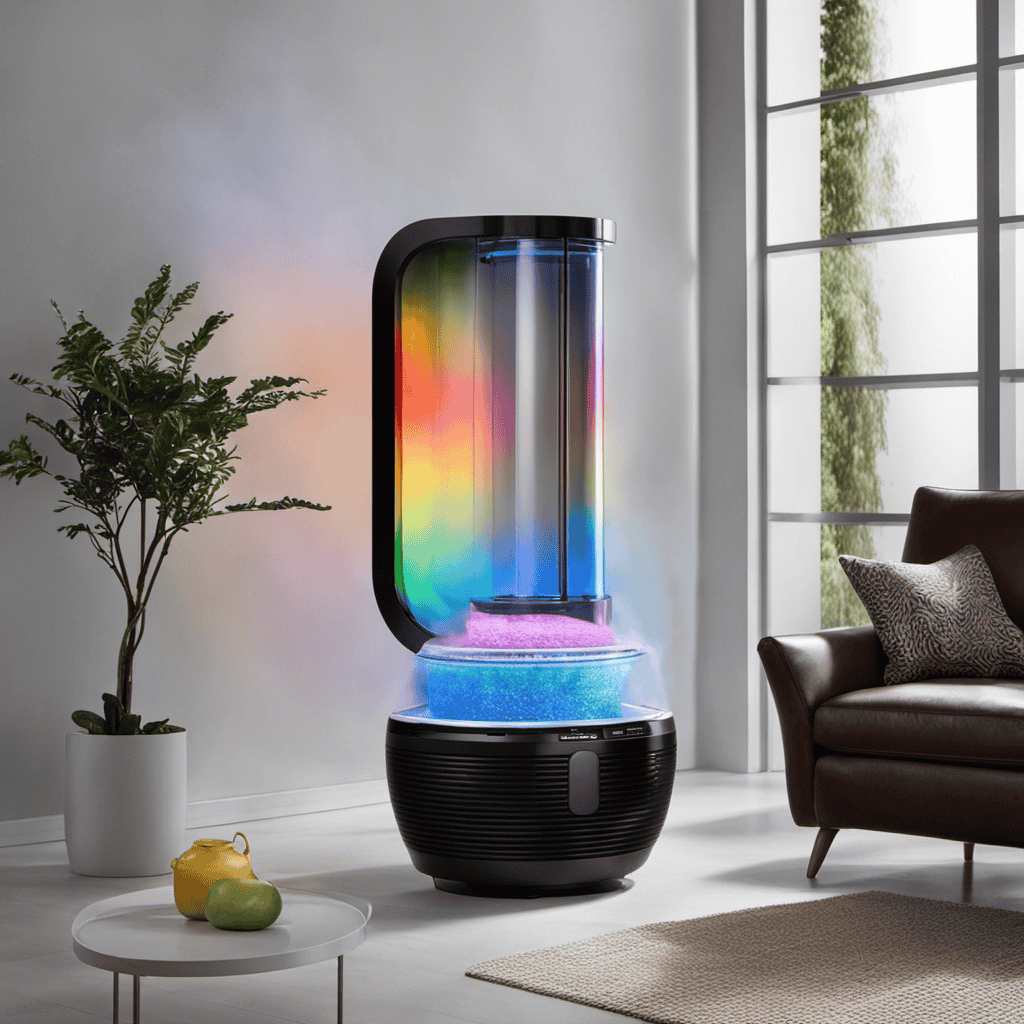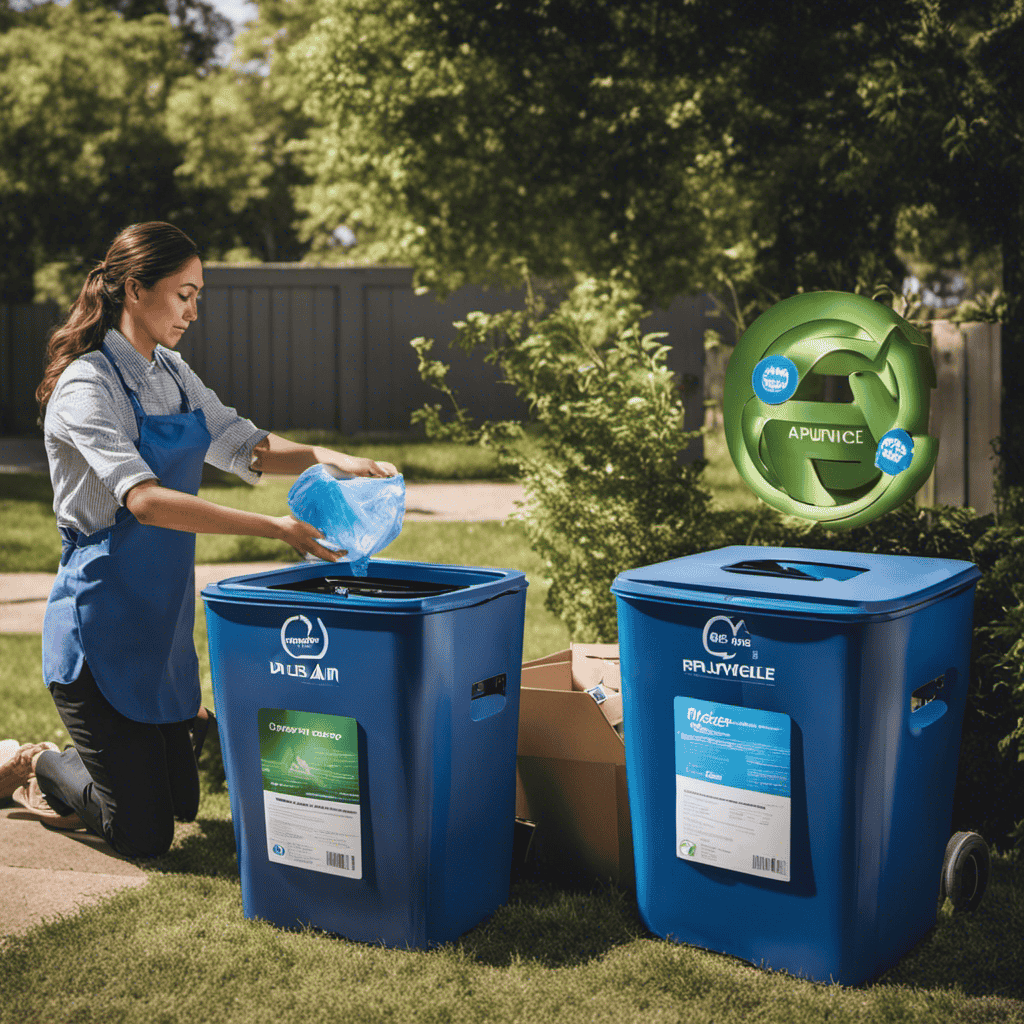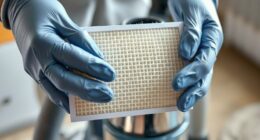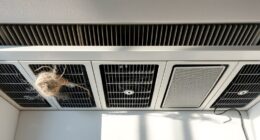I have always been interested in the role of ionizers in air purifiers, as someone who appreciates clean and fresh air. This is why I wanted to explore further the function of Coway air purifiers’ ionizer.
In this article, we’ll explore the benefits of ionizers, how they work, and their effectiveness in removing airborne particles. We’ll also discuss how ionizers neutralize odors, reduce allergens in the air, and potentially alleviate asthma and allergy symptoms.
Plus, we’ll cover important safety precautions when using ionizers in air purifiers.
Get ready to breathe easier with the power of ionization.
Key Takeaways
- Ionizers in Coway air purifiers use charged ions to attach to airborne particles and make them heavier, improving overall air quality.
- Ionizers in Coway air purifiers can reduce allergies, respiratory issues, and alleviate symptoms of allergies, asthma, and other respiratory conditions.
- Coway air purifiers with ionizers emit negatively charged ions that attach to positively charged particles, providing cleaner and healthier air with minimal effort.
- It is important to choose ionizers that are certified as ozone-free and to follow the manufacturer’s instructions and recommendations for usage.
Explanation of Ionizers
An ionizer is a feature in the Coway air purifier that uses charged ions to clean the air around you.
It works by releasing negative ions into the air, which attach themselves to airborne particles, such as dust, pollen, and pet dander.
These charged ions cause the particles to become heavier and fall to the ground or attach to surfaces, effectively removing them from the air you breathe.
The benefits of using an ionizer in an air purifier are numerous.
Firstly, it helps to reduce allergies and respiratory issues by removing allergens and irritants from the air.
Secondly, it can eliminate unpleasant odors, such as cigarette smoke or cooking smells.
Lastly, it can improve overall air quality, making your living space healthier and more comfortable.
Benefits of Ionizers in Air Purifiers
Get ready to experience the benefits of ionizers in your air purifier!
Ionizers play a crucial role in improving respiratory health by reducing indoor pollutants. These devices work by releasing negative ions into the air, which attach to positively charged particles like dust, pollen, and pet dander. As a result, these particles become heavier and are more likely to settle on surfaces or get trapped in the air purifier’s filters.
This process helps to remove these harmful pollutants from the air, creating a cleaner and healthier environment for you and your family. By reducing indoor pollutants, ionizers can help alleviate symptoms of allergies, asthma, and other respiratory conditions.
It’s important to note that ionizers should be used in conjunction with other air purifier technologies to achieve optimal air quality.
How Ionizers Work in Coway Air Purifiers
Experience the advanced technology in Coway air purifiers as they work to improve indoor air quality by reducing pollutants. The ionizers in Coway air purifiers play a crucial role in enhancing the effectiveness of the purification process.
Here are some key points to consider about ionizers in Coway air purifiers:
-
Ionizers help to remove airborne particles by emitting negatively charged ions that attach to positively charged particles, causing them to become heavy and fall to the ground.
-
Coway air purifiers with ionizers have low energy consumption, making them energy-efficient and cost-effective in the long run.
-
Ionizers in Coway air purifiers require minimal maintenance. The ionizer plates can be easily cleaned and reused, eliminating the need for frequent replacements.
-
Coway air purifiers with ionizers are designed to operate quietly, ensuring a peaceful and undisturbed indoor environment.
With Coway air purifiers’ advanced ionizer technology, you can enjoy cleaner and healthier air with minimal effort and energy consumption.
Understanding the Ionization Process
Discover how the ionization process works in the cutting-edge technology of Coway air purifiers. Ionization is a key feature that sets Coway air purifiers apart from others in the market. It involves the release of negatively charged ions into the air, which attach themselves to airborne particles, such as dust, pollen, and pet dander. These particles become heavier and fall to the ground, making the air cleaner and healthier to breathe. The ionization process in Coway air purifiers is simple yet effective. It works by emitting ions through an ionizer plate, which is located inside the purifier. As the air passes through the purifier, it interacts with the ions, resulting in the removal of harmful pollutants. This process not only improves indoor air quality but also offers several benefits, such as reducing allergens, eliminating odors, and neutralizing bacteria and viruses.
| Ionization Benefits | Ionization Process Explained |
|---|---|
| Reduces allergens | Negatively charged ions attach to |
| airborne particles, making them heavier | |
| Eliminates odors | Air passes through an ionizer plate |
| where ions are emitted | |
| Neutralizes bacteria | Ions interact with the air, removing |
| and viruses | harmful pollutants |
Effectiveness of Ionizers in Removing Airborne Particles
Improve the quality of the air you breathe by understanding how effectively ionizers remove airborne particles. Ionizers are electronic devices that release negatively charged ions into the air. These ions attach themselves to airborne particles like dust, pollen, and pet dander, making them heavier and causing them to fall to the ground or be trapped by your air purifier.
Here are four key points to consider about ionizers and their impact on respiratory health and sleep quality:
- Ionizers can help reduce allergens and irritants in the air, improving respiratory health for those with allergies or asthma.
- The removal of airborne particles by ionizers can create a cleaner sleeping environment, potentially leading to better sleep quality.
- Some studies suggest that ionizers may help reduce the presence of certain viruses and bacteria in the air, which can contribute to overall respiratory health.
- It’s important to note that ionizers should be used in conjunction with other air purification methods for optimal results.
Ionizers and Indoor Air Quality Improvement
To enhance the quality of the air you breathe indoors, it’s important to understand how ionizers contribute to improving indoor air quality.
Ionizers play a crucial role in removing airborne particles that can negatively impact respiratory health. These devices release negatively charged ions into the air, which attach to positively charged particles like dust, pollen, and pet dander. As a result, these particles become heavier and eventually settle on surfaces, reducing their presence in the air.
This can be particularly beneficial for individuals with allergies or asthma, as pet dander is a common trigger for respiratory symptoms. By utilizing ionizers, you can effectively reduce the amount of pet dander in your indoor environment, promoting better respiratory health.
Moving forward, let’s explore the role of ionizers in neutralizing odors.
The Role of Ionizers in Neutralizing Odors
Now let’s delve into the role of ionizers in eliminating pollutants and their impact on respiratory health.
Ionizers are designed to release negatively charged ions into the air, which attach to positively charged particles like dust, pollen, and smoke. These charged particles then become heavier and fall to the ground or get trapped in filters, effectively removing them from the air.
Here are some key points about ionizers and their impact:
- Ionizers can help reduce the presence of allergens in the air, such as pollen and pet dander.
- They can also neutralize odors caused by smoke, cooking, or pets, making the air fresher and more pleasant.
- Ionizers may have a positive effect on respiratory health by reducing the number of airborne particles that can irritate the lungs.
- Some studies suggest that ionizers may also have antibacterial properties, helping to reduce the spread of germs in the air.
With this understanding of the role of ionizers in eliminating pollutants and their impact on respiratory health, let’s now explore how ionizers can contribute to allergen reduction in the air.
Ionizers and Allergen Reduction in the Air
When it comes to improving air quality, ionizers are often touted as an effective solution. These devices work by releasing negatively charged ions into the air, which then attach to and neutralize pollutants, such as dust, pollen, and mold spores.
However, it is important to consider the effectiveness of ionizers in actually improving air quality, as there is ongoing debate and mixed research findings on their true impact.
Ionizers and Air Quality
The ionizer in the Coway air purifier helps improve air quality by removing harmful particles. It works by releasing negatively charged ions into the air, which attach to positively charged particles like dust, allergens, and pollutants. These particles then become heavier and fall out of the air, making the air cleaner and healthier to breathe.
Here are four key points about ionizers and their impact on air quality:
-
Ionizers can help reduce respiratory health issues by removing allergens and irritants from the air, such as pollen, pet dander, and mold spores.
-
Ionizers have the potential to improve energy consumption as they can help reduce the need for other air cleaning methods, like frequent filter replacements.
-
It is important to note that ionizers may produce small amounts of ozone as a byproduct, which can be a concern for individuals with respiratory conditions like asthma.
-
The effectiveness of ionizers in improving air quality may vary depending on factors such as room size, air circulation, and the presence of other air pollutants. Regular maintenance and proper usage are recommended to ensure optimal performance.
Effectiveness of Ionizers
Ionizers can be effective in improving air quality by removing harmful particles and reducing respiratory health issues. The effectiveness of ionizers lies in their ability to produce negative ions, which attach to airborne pollutants, causing them to become too heavy to stay in the air. As a result, these particles fall to the ground or surfaces, making it easier to clean them up.
This process can significantly reduce the presence of allergens, dust, and other harmful particles in the air, leading to better indoor air quality. The health benefits of ionizers include reducing symptoms of allergies and asthma, as well as improving overall respiratory health. By removing airborne irritants, ionizers can help alleviate coughing, sneezing, and wheezing associated with these conditions.
Transitioning into the next section, let’s explore how ionizers specifically impact asthma and allergy symptoms.
Ionizers and Their Impact on Asthma and Allergy Symptoms
Using ionizers can help alleviate asthma and allergy symptoms. Ionizers are devices that release negatively charged ions into the air. These ions attach themselves to allergens, dust particles, and other pollutants, causing them to become heavy and fall to the ground. This helps to reduce the number of airborne allergens and irritants, which can trigger asthma attacks and allergic reactions.
The impact of ionizers on respiratory health is significant, as they can improve indoor air quality and create a healthier environment for individuals with asthma and allergies. Some benefits of using ionizers include:
- Reduction of airborne allergens and irritants
- Improved air quality and breathing
- Decreased asthma symptoms and allergy flare-ups
- Enhanced overall respiratory health
It is important to note that while ionizers can be helpful in managing asthma and allergies, they should not be relied upon as the sole method of treatment. Consultation with a healthcare professional is essential for proper asthma management.
Safety Precautions and Considerations When Using Ionizers in Air Purifiers
When considering safety precautions, it’s essential to be aware of potential ozone emissions from ionizers in air purifiers.
Ionizers are designed to improve air quality by releasing negatively charged ions into the air, which attach to pollutants and remove them from the environment. However, some ionizers produce ozone as a byproduct, which can be harmful to human health.
Ozone is a lung irritant and can exacerbate respiratory conditions such as asthma and allergies. To ensure the safety of using ionizers in air purifiers, it is crucial to choose models that have been certified as ozone-free by recognized standards organizations.
Additionally, it is important to follow the manufacturer’s instructions and recommendations for usage to minimize any potential health risks associated with ozone emissions.
Frequently Asked Questions
Can Ionizers Cause Any Negative Health Effects?
Ionizers can potentially cause negative health effects, especially on children. Long-term use of ionizers may pose risks such as respiratory issues and increased ozone levels. It is important to consider these factors before using an ionizer.
Do Ionizers Produce Any Harmful Byproducts?
Ionizers can improve indoor air quality by removing harmful particles and allergens. They release negative ions that attach to these pollutants, causing them to fall to the ground. This can benefit your home environment by reducing respiratory issues and allergies.
Are Ionizers Noisy When They Are Running?
Yes, ionizers can be noisy when running, but the noise level varies depending on the model. It’s important to consider noise levels when purchasing an air purifier.
Can Ionizers Be Harmful to Pets or Plants?
Ionizers can effectively reduce pet allergies by removing allergens from the air. However, they may have a negative impact on indoor plant growth, as ionized particles can interfere with photosynthesis.
How Long Do Ionizer Plates Last Before They Need to Be Replaced?
To clean ionizer plates, I use a damp cloth to wipe away any dust or dirt. To extend their lifespan, I make sure to clean them regularly and avoid placing them near sources of smoke or chemicals.
Conclusion
In conclusion, the ionizer feature in Coway air purifiers plays a crucial role in enhancing the overall air purification process. By releasing negatively charged ions into the air, these devices effectively neutralize odors and reduce allergens.
Furthermore, they can help alleviate asthma and allergy symptoms. However, it’s important to follow safety precautions and consider the specific needs of your environment before using an ionizer.
As the saying goes, ‘knowledge is power,’ and understanding how ionizers work can empower you to make informed decisions about your indoor air quality.

